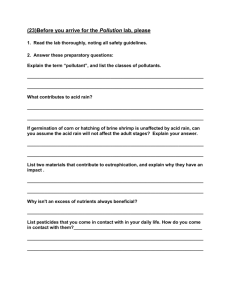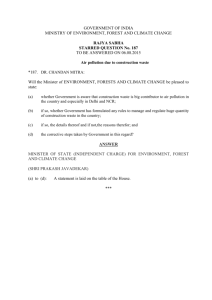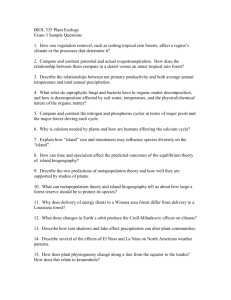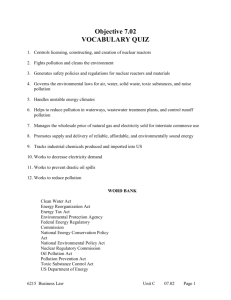Unit 4 - SNS Courseware
advertisement
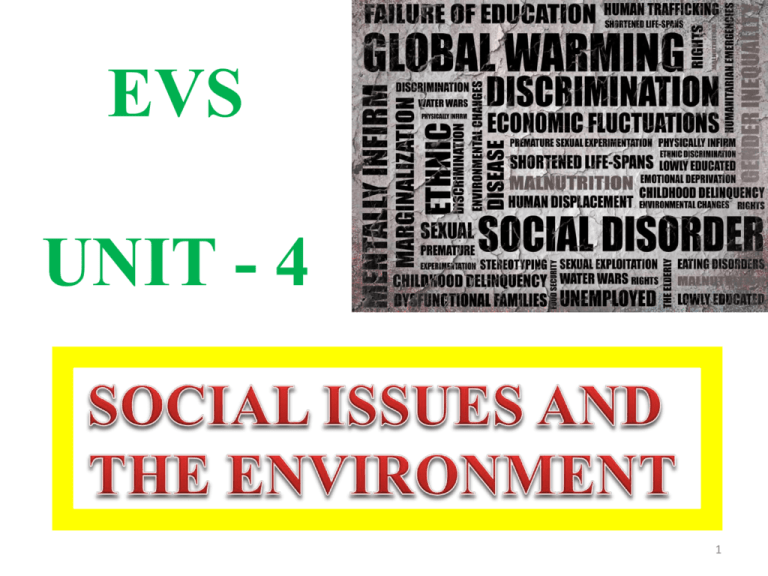
EVS UNIT - 4 1 2 3 Significance of sustainable development • Developing appropriate technology • Reduce , reuse, recycle of natural resources • Providing environmental education and awareness • Consumption of renewable resources • Conservation of non-renewable resources • Population control 4 Urban problems related to energy • Energy demanding activities • Solution for urban energy problem WATER CONSERVATION Need for water conservation: • Population increases • Due to deforestation annual rainfall decreases • Over exploitation of ground water 5 Ways of water conservation • Reducing evaporation loss • Reducing irrigation loss • Reuse water • Avoid sewage discharge Water conservation method • Rain water harvesting • Watershed management 6 RAIN WATER HARVESTING Rain water harvesting techniques There are two main techniques for rain water harvesting: 1. Storage of rain water on the surface for future use 2. Recharge of ground water 7 8 Objectives of rain water harvesting • To raise the water table by recharging the ground water. • To minimize water crises and water conflicts • To reduce rain water run off and soil erosion. • To reduce the ground water contamination from intrusion of saline water 9 WATERSHED MANAGEMENT It is defined as land area bounded by divide line from which water drains under influence of gravity in to stream, lakes, reservoir. The management of rainfall & resultant runoff. 10 Advantages of Watershed projects - Improved access to drinking water in project areas during drought - Increase in cultivation area leading to increase in employment - Increase in crop yield, resulting better income to rural population - Improved availability of fodder for animals and increase in milk yield - Increase in employment & involvement of women - Increase in net returns from all crops. - Decrease in soil erosion. - Restoration of ecological balance. 11 RESETTLEMENT AND REHABILITATION Resettlement – simple relocation or displacement of human population. Rehabilitation – making, system to work again by allowing, system to function naturally. Includes replacing the lost economic assets, Safeguard Employment, Provide safe land for building. Effects: • Loss of land • Loss of recourse • Unsatisfactory compensation • Social and cultural problems • Changes in tradition of indigenous people • Spread of disease • Submergence of valuable forest • Water logging 12 • Extinction of wild life ENVIRONMENTAL ETHICS Refers to the issues, principles and guidelines relating to human interactions with their environment. 13 Solutions Reducing the energy sources Recycle and reuse of waste products Soil degradation Sustainable development Protection of Bio – diversity Reducing the population. 14 The raise of earths surface temperature due to intense green house effect is called global warming. CO2, CH4, N2O, CFC’s. 15 Causes: Over the last century, CO2 – 25% N2O – 19% CH4 – 100% burning of fossil fuels, industrialization, mining, deforestation, exhaust from increasing automobiles and other anthropogenic activities. 16 EFFECTS OF GLOBAL WARMING: 1.Sea level increases as result of melting and thermal expansion of ocean. 2. High CO2 level in the atmosphere have a long term negative effect on crop production and forest growth. 3. Global rainfall pattern will change .Drought and floods will become more common. Raising temperature will increase domestic water demand. 4. Many plants and animal species will have a problem of adapting. Many will be at the risk of extinction, more towering verities will thrive. 5. As the earth becomes warmer the floods and drought becomes more frequent. There would be increase in water-borne diseases. 17 MEASURES TO CHECK GLOBAL WARMING: 1. CO2 emission can be cut by reducing the use of fossil fuel. 2. Plant more trees. 3. Shifting from coal to natural gas. 4. Stabilize population growth. 5. Remove efficiently CO2 from smoke stocks. 6. Removal of atmospheric CO2 by utilizing photo synthetic algae. 18 ACID RAIN: • Normal rain water is always slightly acidic ( pH 5-5.6) because of CO2 present in the atmosphere gets dissolved in it. • Due to presence of SO2 and NO2 gases as pollutants in the atmosphere. • The pH of the rain is further lowered. • This type of precipitation of water is called acid rain. 19 20 Effect on human being: • Human nervous system respiratory system and digestive system are affected by acid rain. • It cause premature death from heart and lung disorder like asthma, bronchitis. Effects On building: • At present TajMahal in Agra is suffering due to SO2 and H2SO4 fumes from Madura refinery. Acid rain corrodes houses, monuments ,statues ,bridges and fences. • Acid rain causes corrosion of metals. 21 Effect on Terrestrial and lake Ecosystem • Reduce the rate of photosynthesis and growth in terrestrial vegetation. • Acid rain retards the growth of crops like beans potatoes ,carrot ,spinach. Acid rain reduces fish population ,black flies, mosquitoes ,deer flies occurs largely which causes number of complications in ponds rivers and lakes. • Activity of bacteria and other microscopic animals is reduced in acidic water. The dead materials are not rapidly decomposed. Hence the nutrients like N,P are locked up in dead matter. 22 Control measures •Clean combustion technologies •Using pollution control equipments •Replacement of coal by natural gas •Liming of lakes and soils. 23 Ozone is an important chemical species present in the stratosphere. Its conc. is about 10 ppm. It acts as a protective shield for the life on the earth. Ozone is produced and also broken down by photochemical reactions, thus maintaining equilibrium. 24 Causes for ozone layer depletion: 1. Chlorine released from CFC and Bromine released from halogens are the most important chemicals associated with ozone layer depletion 2. The halogens are used in fire extinguishers and CFC are extensively used in air conditioners and refrigerators. 3. Methyl bromide used during packaging of fruits to prevent bacterial action flows out into the atmosphere as soon as the packing is opened. This cause heavy damage to ozone. 4. High altitude aircrafts and chemicals emitted by industrial plants and automobiles. 25 26 NUCLEAR ACCIDENTS • Energy released—during a nuclear reaction is called nuclear energy. • Nuclear fission and Nuclear fusion are used to prepare nuclear energy. • During nuclear accidents large amount of energy and radioactive products are released into the atmosphere. Nuclear Holocaust Destruction of Biodiversity by nuclear equipments and nuclear bombs is called nuclear holocaust. 27 Types of nuclear accidents Nuclear Test Nuclear explosions –release radioactive particles and radioactive rays into the atmosphere. Nuclear power plant accidents Nuclear power plants located in seismic vulnerable area may cause nuclear accidents which releases radiation. Improper disposal of radioactive wastes Drums with radioactive wastes, stored underground rust and leak radioactive wastes into water , land and air. 28 Effects of nuclear radiation 1. Radiation affects DNA in cells. 2.Exposure to low dose of radiation - people suffer from fatigue, vomiting ,and loss of hair. 3. Expose to high radiation affect bone marrow, blood cells, natural resistance fail of blood clot. 4. Exposure to very high dose of radiation kills organisms by damaging the tissues of heart and brain. 29 Nuclear holocaust in Japan • In 1945 two nuclear bombs were dropped in Hiroshima and Nagasaki in Japan . • About 1,00,000 people were Killed and the cities were badly destroyed. • This explosion emitted forceful neutrons and gamma radiation. • Radioactive Strontium liberated in the explosion replaced calcium in the bones. • Large scale bone deformities Occurred in the people of these cities. 30 Waste land reclamation • Any land which is not put to optimal use is defined as waste land. • The waste land do not fulfil their life sustain potential wasteland contributes about 20.17% of the total geographical area of India. 31 New vocabulary for your list • Polder- land that is reclaimed from the sea or other body of water by diking and drainage. • Landfill- a site for the disposal of waste materials by burial. • Terrace Farming- used to grow crops on sloped land. Terraced fields decrease erosion, and effective for growing crops. • Paddy Fields- is a flooded piece of arable land used for growing rice and other crops. 32 Reasons for formation • Over grazing and over exploitation • Toxic effluent discharged from sewage and industrial wastes • Mining activities destroy forest and cultivable land • Use of pesticides also produce wasteland • Erosion, desertification, water logging also degrade land Wastelands can be reclaimed by the following way • Conserving the soil – land is brought under vegetal cover. This can be done by growing grasses and shrubs • To reclaim the land/soil, effective participation of the people, voluntary agencies and government is very important 33 Kansai opened in 1994 to relieve overcrowding at Osaka Airport 34 Dubai 35 Terrace Farming in China- Another form of land reclamation 36 Consumerism and Waste Products • Consumerism refers to the consumption of resources by the people. • Consumerism is related to both population size and increase in demands due to change in life style. • Population has increased tremendously. • World Bank estimates our population to reach 11 billion by 2045. 37 Parameter Global Value % USA India Population 4.7 16 Production of goods 21 1 Energy use 25 3 Pollutants and wastes 25 3 CFC Production 22 0.7 38 39 Environmental Protection Act • This act empowers the central govt. to fix the standards for quality of air, water, soil, and noise. • The central govt. formulates procedures and safe guards for handling of hazard substances. Important features: 1. This act empowers the govt. to lay down procedures and safe guards for the prevention of accidents which cause pollution and remedial measures if accidents occur. 40 2. The govt. has the authority to close or prohibit or regulate any industry or its operation if the violation of provisions of the act occurs. 3. Violation of the act is punishable with imprisonment for 5 years or fine of one lakh or both. 4. If violation continues an additional fine of Rs5000 per day may be imposed for entire period of Violation of rules. 5. The act empowers the officer of the central govt. to inspect the sight or the plant or machinery for preventing pollution and to collect samples of air , water, soil and other materials from any factory or its premises for testing. 41 Air (Prevention & Control of Pollution) Act, 1981 • This act was enacted in the conference held at Stock Holm. • It envisages the establishments of central and State control boards to monitor air quality and pollution control. Salient features: 1.The central board may lay down the standards for quality of air. 2. The central board co-ordinates and settle the disputes between state boards. 42 4. The state boards are empowered to lay down the standards for emission of air pollutants from industries or other resources. 5. The state boards are to examine the manufacturing processes and control equipment for for the prescribed standards. 6. The direction of central board is mandatory on state boards. 7. With out the consent of the central board operation of an industrial unit is prohibited in heavily polluted area. 8. Violation of law is punishable with imprisonment for three months or fine of Rs 10000 or both. • This act applies to all pollution industries. This act empowers the state board to order • closure of any industrial unit or stoppage of water supply or stoppage of electricity. 43 Water ( prevention and control of pollution ) Act, 1974 • This act provides for maintaining and restoring the sources of water. • It also provide for preventing and controlling water pollution. Salient features: 1. This act aims to protect the water from all kind of pollution and to preserve the quality of water in all aquifers. 2. The act further provides for the establishment of central board and state boards for prevention of water pollution. 44 3. The states are empowered to restrain any person from discharging a pollutant (or) sewage (or) effluent into any water body with out the consent of the board. 4. The act is not clear about the definition of pollutant, discharge of pollutant toxic pollutant. State pollution control board The consent of this board is needed 1. To establish any industry or any treatment and disposal system or any extension or addition which likely discharge or trade effluent into a stream or well or river or on land. 2. To use any new or altered outlet for the discharge of sewage. 3. To begin to make any new discharge of sewage. • Act also empowers the state board to order closure or stoppage of supply of electricity, water or any other service to the polluting unit. 45 Wild Life Act 1972 • This act was amended in 1983, 1986, and 1991. • This act is aimed to protect and preserve all animals and plants that are not domesticated. • India has 350 species of mammals, 1200 species of birds and about 20000 known species of insects. • Some of them are listed as endangered species in wild life protection act. 46 • Wild life is declining due to human action. Wild life products like skins, firs, feathers, Ivory etc. have decimated the population of many species. • Wild life population monitored regularly and management strategies formulated to protect them. Important Features 1. The act covers the rights and non- rights of forest dwellers. 2. It allows restricted grazing in sanctuaries but prohibits in national parks. 3. It also prohibits the collection of non timber forest. 4. The rights of forest dwellers recognized by forest policy of 1988 are taken away by amended wild life act of 1991. 47 Forest (Conservation) Act 1980 • This act is enacted in 1980. It aims to arrest deforestation. This act covers all types of forests including reserved forests, protected forests and any forest land. Salient features 1. State government can use forest for forestry purpose. 2. Provision for conservation of all types of forests. Advisory committee appointed for funding conservation 3. Illegal non-forest activity within a forest area can be immediately stopped under this act. Non forest activity means clearing land for cash-crop agriculture, mining etc. 48 1992 Amendment: 1. This amendment allows transmission lines, seismic surveys, exploration drilling and hydro electric project in forest area without cutting trees or with limited cutting of trees – prior approval CG to be sought. 2. Wild life sanctuaries, National parks etc. are prohibited from exploration except with CG prior approval. 3. Cultivation of coffee, rubber, tea (cash crop), fruit bearing trees, oil yielding trees, trees of medicinal values are also prohibited in reserved forest area with out prior approval from CG. As this may create imbalance to ecology of the forest. 49 4. Tusser (a type of silk yielding insect) cultivation in forest area is allowed since it discourages monoculture practices in forests and improves biodiversity. 5. Plantation of mulberry for rearing silk worm is prohibited. 6. Proposal sent to CG for non-forestry activity must have a cost benefit analysis and environmental impact statement (EIS). 50 Environmental Legislation • 1972 June 5th – Environment was first discussed as an agenda in UN conference on Human Environment. There after every year 5th June is celebrated as Environment Day. Constitutional Provisions: • Added in 1976 – Article 48A – “The state shall endeavor to protect and improve the environment and to safeguard forests and wildlife of the country” 51 • Article 51A (g): “It shall be the duty of every citizen of India to protect and improve the natural environment including forests, lakes, rivers and wildlife and to have compassion for living creatures”. • By these two articles one constitution makes environment protection and conservation as one of our fundamental duties. 52 Enforcement of environmental legislation – major issues 1. Target of 33% of land to be covered by forest not achieved 2. Rivers turning to open sewers 3. Big towns and cities polluted 4. Wild life endangered 5. EFP (Effluent Treatment Plant) or Air Pollution Control devices are expensive – leads to closure of units. Government should provide subsidy for small units. 53 6. Pollution control laws not backed up by policy pronouncements or guidelines 7. Chairman of PCB – political nominee. Hence political interference. 8. Involving public in decision making envisaged by policy statement of the ministry of environment and forest (1992) is only in paper. 54 Draw backs of wild life (protection) act • Fall out of Stockholm conference not localized • Ownership certificate of animals article – illegal trading • Trade through J & K. This act not applicable to J&K • Offender to get just 3 years imprisonment and or Rs.25000/- fine. 55 Draw backs of the forest (conservation) act 1980 • Inheritance of exploitative and consumerist elements of the British period • Tribal people (i.e.) inhabitants of forest are left by the act • Instead of attracting public support (tribal) it has intrigued in the human rights. • Protection of trees, birds and animals have marginalized poor people. 56 Central and state pollution control Board Central pollution control Board (CPCB): 1. Advices CG in matters – prevention and control of water pollution 2. Co ordinates SPCB and provide technical assistance and guidance 3. Training programs for prevention and control of pollution by mass media and other ways 4. Publishes statistical and technical details about pollution 57 5. Prepares manual for treatment and disposal of sewerage and trade effluents 6. Lays std for water quality parameters 7. plans nation-wide programs for prevention, control or abatement of pollution 8. Laboratories for analysis of water, sewage or trade effluents 58 State pollution control Board (SPCB): SPCB has similar functions as CPCB and governed by CPCB 1. SPCB advises state government w.r.t. location of any industry that might pollute. 2. Lays standards for effluents to take samples from streams, wells or trade effluents or sewage passing through an industry. Samples taken are analysed at recognized labs. If the sample is not confirming to the water quality std, then the unit is neglected. 3. Every industry to obtain consent from PCB before commencing an effluent unit by applying in prescribed form with fee. 59 PUBLIC AWARENESS Our environment is presently degrading due to many activities like pollution, deforestation, overgrazing, rapid industrialization and urbanization. Objectives of public awareness • Create awareness among people of rural and city about ecological imbalances, local environment, technological development and various development plants. 60 • To organize meetings, group discussion on development, tree plantation programmes exhibitions. • To learn to live simple and eco-friendly manner. Methods to create environmental awareness In Schools and Colleges Mass media Cinema Newspapers Audio – Visual media Voluntary organization Traditional techniques Arranging competitions Leaders appeal NGO’S 61 62



